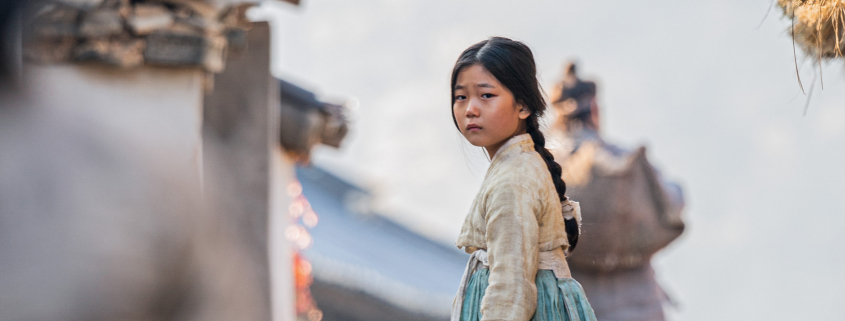‘Pachinko:’ a family epic for the ages

Adapted from Min Ju Lee’s 2017 New York Times bestselling novel of the same name, “Pachinko” tells a multi-generational story of a Korean woman and her family who moved to Japan during the Japanese colonization of Korea. Set against the backdrop of this harsh colonial regime, “Pachinko” tells a heart-wrenching and compelling story of love, family, hardship and discrimination throughout the 20th century.
With well-received, emotionally dense source material, the “Pachinko” TV adaptation, which premiered March 25 on Apple TV, certainly had large shoes to fill — and fill them they did.
The pilot switches between 1910s Korea, where the young protagonist Sunja (Minha Kim, Jeon Yu-na, and Youn Yuh-jung) grow up under the watch of her loving parents and less loving Japanese colonizers, and 1980s Japan, where Sunja’s grandson, uber ambitious New York banker Solomon (Jin Ha), returns to his childhood home of Japan (where Sunja now lives) to clinch a property development deal.
While this is all the pilot holds, readers of the novel will know just how many storylines “Pachinko” will cover, as the book traces Sunja’s entire life and family throughout the 20th century. The pilot of “Pachinko,” especially with its long, highly stylized, “Succession” like, title sequence, establishes that “Pachinko” is not a typical K-drama — it’s a Korean American family epic that is only just getting started.
Ping-ponging between these two eras, “Pachinko” deftly represents and unpacks the traumatic history and structural racism foundational to the Korean-Japanese relationship.
“Pachinko” does no favors to the Japanese in relation to the Korean experience — it represents Japanese forces in the 1910s as oppressive invaders, and in the 1980s, as a nation that still hasn’t much improved in their racial equality. “Pachinko” also doesn’t falsely represent Korea as a scarcely populated, impoverished country that might benefit from colonial occupation. Instead, it fully respects that state of prewar Korea, centering and uplifting the human stories of a nonindustrially developed nation in a respectful and noncondescending way — not often seen in major television.
However, “Pachinko” cannot claim to be an entirely fresh, groundbreaking show.
It still employs the standard drama tropes, such as the casual racism of the extreme American wealthy as a catalyst for the money and prestige-obsessed, male protagonist’s storyline, or the typical fairytale story of Sunja’s strict mother and overly doting father. However, it mixes these tropes with the more touching and new environment of an extremely tumultuous period.
Ultimately, while “Pachinko” doesn’t significantly stray from the world of melodramatic period pieces, its touching story proves that it doesn’t need to, that this genre is a perfectly suitable vessel for its message.
“Pachinko” may tell a politicized story, but the incredibly personal and human way the story is told seems more inspired by a need for catharsis and representation than a political agenda.
Beyond the emotional writing, “Pachinko” stands out with its beautiful look — vast landscapes and lush environments meld with a strong, purposeful color palette that provides a highly immersive experience for the viewer.
Unlike common practice, the colors and designs for this show do not differ for different time periods — rather, each period retains the same style and cinematography, creating a cohesive effect further connecting the seemingly drastically different storylines even when they seem vastly different. For example, blue, foggy fishing docks in the 1920s translate easily to a smog-filled, light blue morning in 1989 Tokyo.
“Pachinko” is touched with a layer of softness, even in night scenes. Despite the subtlety in brightness, the vibrancy and diversity of color smartly still prevent the lighting and design from becoming too nostalgic or dreamlike. Everything may appear to be gentle, but it’s certainly not quiet — it’s a color tone that fits the characters and the story’s themes.
The star-studded cast of “Pachinko” also blends so well into this world that it felt completely normal to see megastars such as Lee Min-ho (Boys over Flowers”) and Youn Yuh-jung (“Minari”), blend in with prewar Korean fishing markets and 1980s Japan. But most importantly, the casting of young Sunja — breakout star Jeon Yu-na — may have been this show’s best decision.
Jeon’s adorable physicality and incredibly emotional talent, such as her slow production of tears while watching Japanese soldiers beat a fisherman, make this suspenseful and depressing show only more heart-wrenching for viewers. Sunja’s ever-present naive and childlike innocence perfectly juxtaposes an ever-present, ominous tone that perpetually reminds viewers that no one gets by in this world unscathed.
“Pachinko” is a master class in downer television that still has a warm and positive heart — for “Pachinko,” that heart can be seen under layers of suspense and loss in its beautiful representation of Korea and Korean communities and its cathartic message of family and love.
The twisting, suspenseful storylines and audience-focused acting denote this show as a K-drama at heart, but certainly not something that will fit easily in a box. Instead, most of the narratively complex and rich story has yet to unfold in what will surely become an unprecedented family epic for the ages.
Rating: 5/5

